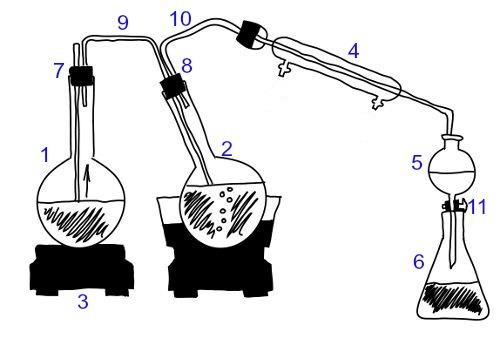the method of separation of mixtures called steam distillation it is the way in which so-called essential oils (essences) are obtained. An essential oil is a liquid obtained from plants and can be used in various fields, such as medicine and in the manufacture of perfumes or products used for cleaning.
To carry out the steam distillation, it is necessary to assemble a whole set of equipment. See the diagram below:

Schematic apparatus of a steam drag distillation
The equipment used are:
two round bottom balloons (numbers 1 and 2);
a heating plate (number 3);
a capacitor (number 4);
a bromine funnel (number 5);
two Erlenmeyers (number 6);
wooden stoppers for the balloons (numbers 7 and 8);
U-shaped glass tubes to connect the balloons and these to the condenser (keys 9 and 10).
Assembled the appliance, steam distillation follows with the addition of a certain volume of water in the first round bottom flask (1). This water is heated by the heating plate. In balloon 2, place the plant that will be used to extract the essential oil. To be placed in the balloon, the plant must be crushed or crushed and mixed with a small amount of liquid water.
When the water vapor produced in balloon 1 reaches balloon 2 through the U-tube, it comes into contact with the plant and causes substances that have a low boiling point to be transformed into steam and directed to the condenser. Upon entering the condenser, the vapors are condensed and turned into liquids, which are then collected in the bromine funnel (5).
The substances that are vaporized from the plant then form the essential oil. All essential oil produced using this method is immiscible (does not dissolve) in water. When the liquid water and essential oil reach the bromine funnel, they are decanted (mixture is left to stand). After a while, there will be a heterogeneous mixture, in which water is the lower phase (densest liquid) and essential oil is the upper phase (less dense liquid).
Since the bromine funnel has a valve (key 11), when it is opened, water falls into the Erlenmeyer flask. When the essential oil reaches the valve region, we close the valve and exchange the erlenmeyer with water for the other empty erlenmeyer flask to collect the essential oil.
By Me. Diogo Lopes Dias
Source: Brazil School - https://brasilescola.uol.com.br/quimica/destilacao-por-arraste-vapor.htm
